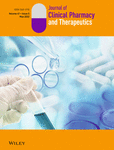Clinical outcomes and safety of osimertinib plus anlotinib for patients with previously treated EGFR T790M-positive NSCLC: A retrospective study
Bin Zhou and Qiang Gong equally contributed to this work.
Funding information
No external funding was used in the preparation of this article.
Abstract
What is known and objective
Although osimertinib achieved convincing efficacy for patients with EGFR T790M-positive non–small-cell lung cancer (NSCLC) as second-line treatment in the AURA3 clinical trials, patients developed drug resistance ultimately. Therefore, the present study was to investigate the clinical outcome and safety of osimertinib plus anlotinib for patients with previously treated EGFR T790M-positive NSCLC.
Methods
Designed as a retrospective study, this study consecutively included a total of 33 patients with advanced NSCLC who possessed a EGFR T790M-positive mutation and progressed after the first-line therapy. Eligible patients were treated with osimertinib plus anlotinib. Baseline characteristics of the patients were collected during hospitalization. Efficacy of the combination regimen was assessed with the change of target lesion using imaging evidence according to RECIST 1.1 criteria, and all the patients were followed up regularly. Adverse reactions were collected and documented during the treatment. Univariate analysis according to baseline characteristic subgroups was performed using log-rank test, and multivariate analysis was carried out by Cox regression analysis.
Results and discussion
The best overall response of the patients during osimertinib and anlotinib combination indicated that complete response was found in one patient, partial response was observed in 26 patients, stable disease was noted in 5 patients and progressive disease was reported in one patient. Therefore, objective response rate (ORR) of the combination regimen was 81.8% (95%CI: 64.5%–93.0%), and disease control rate (DCR) was 97.0% (95%CI: 84.2%–99.9%). Furthermore, the median progression-free survival (PFS) of the 33 patients with NSCLC was 15.5 months (95%CI: 6.19–24.81). In addition, the median overall survival (OS) of the 33 patients with NSCLC was 23.8 months (95% CI: 17.67–29.93). Safety profile suggested that the most common adverse reactions of the patients with NSCLC who received anlotinib plus osimertinib were hypertension (63.6%), fatigue (57.6%), diarrhoea (48.5%%), dermal toxicity (39.4%) and proteinuria (33.3%). Interestingly, multivariate Cox regression analysis for PFS demonstrated that ECOG performance status was an independent factor to predict the PFS of the combination regimen.
What is new and conclusion
Osimertinib plus anlotinib regimen preliminarily exhibited encouraging clinical outcomes and acceptable safety profile for patients with previously treated EGFR T790M-positive NSCLC numerically. This conclusion should be validated in prospective clinical trials.
CONFLICT OF INTEREST
The authors declare that they have no competing interests.
Open Research
DATA AVAILABILITY STATEMENT
The data sets generated and analysed during the current study were available from the corresponding author on reasonable request.




